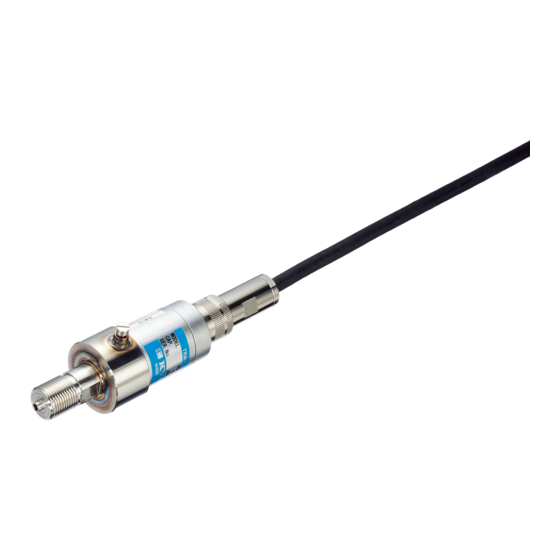
Table of Contents
Advertisement
Quick Links
P G -U Pressu re Tran sd u cers INSTR UCTION MANUAL
Thank you for purchasing the KYOWA product. Before using it, read this
instruction manual carefully. Also, keep the manual within easy reach so
that you can refer to whenever necessary.
Specifications and dimensions described in this manual could be changed
without notice. Please visit our website for the latest version.
1. Callin g th e o p erato r' s atten tion
The following cautionary symbols and headlines are used to invite the
operator' s attention. Be sure to observe the accompanying precautions in
order to safeguard the operator and preserve the performance of the
instrument.
Improper handling can cause serious injury to the
W arn in g
operator.
Improper handling can cause deleterious effects to
Cau tio n
the operator' s body.
Cautions are given to invite the operator' s
Cau tion
attention, in order to avoid instrument failure or
mal- function.
2. Im p o rtant n otice
Unless specified, the transducer must not be used under hydrogen
environment.
3. Safety p recau tio n s
Avoid pressure in excess of the allowable overload rating, or the
instrument can explode.
Avoid contact of a projecting object with the sensing surface, or the
latter may crack to result in the transducer' s explosion.
Use the specified tightening torque. Improper tightening torque may
cause the transducer' s explosion.
If excessive pressure could possibly occur, provide protective casing
around the transducer installation, in order to safeguard the operator.
Select sufficiently strong material for mounting screw hole.
Dismount the transducer only after the applied pressure has been
completely removed.
SUS630 (JIS G4303) is used where the transducer contacts a liquid.
Avoid application of the transducer to a corrosive liquid or gas.
Do not use PG- 200KU to PG- 500KU for endurance / fatigue tests.
The PG- U have air vent screw with slot. Avoid using for a long- term
measurement of gas pressure if much importance is attached to the
stability of output in a minute range.
W arn in g
Cau tio n
4. Han d lin g precau tio n s
Cau tio n
Do not disassemble the transducer.
Take care to keep the liquid- contacting part and mount screw from
damages.
Protection code is IP54. It should not be used underwater.
No condensing. If it formed condensation, immediately dry.
Do not bend the cable at its outlet.
Make sure that the bending radius of cable is longer than 6 times of a
diameter of the cable.
In vibration environment, fix the cable at its outlet and required
portions.
Mount the transducer possibly closest to the pressure source.
If the rising time of the dynamic phenomenon to be measured is short,
the total response including the transducer and measuring instrument in
use may be problem.
Before measurement, check their specifications.
5. Mo u n tin g
5.1 Using a gasket, mount the transducer. Apply your spanner to the
spanner rest on the connecting screw section (Flat- to- flat 14mm) or
the transducer may be damaged. Also, turn the cable together to
protect the cable from damage due to twisting.
・ Recommended tightening torque is 30 N- m.
・ Allowable maximum tightening torque is 60N- m.
5.2 Use a new gasket.
5.3 A seal tape may be tied around the screw for sealing.
5.4 If the measurement object fluid is a liquid, allow the liquid to enter into
the pressure chamber by loosening the needle screw provided on the
transducer, thereby letting contained air go out.
・ Tightening torque for the needle screw is 0.5 N- m.
5.5 When conduit is used, install a cock or valve between the conduit and
connection portion to easily mount and demount the wire conduit.
IM-T-113T J ul 2022
Advertisement
Table of Contents

Subscribe to Our Youtube Channel
Summary of Contents for KYOWA PG-2KU
- Page 1 IM-T-113T J ul 2022 P G -U Pressu re Tran sd u cers INSTR UCTION MANUAL Thank you for purchasing the KYOWA product. Before using it, read this 4. Han d lin g precau tio n s instruction manual carefully. Also, keep the manual within easy reach so that you can refer to whenever necessary.
- Page 2 Cau tio n 6.1 Connect the transducer to a measuring instrument. To measure insulation resistance, apply a voltage lower than 50V to 6.2 When using a measuring instrument other than KYOWA, connector the insulation resistance tester. plug as follows. 9. Specifications Natural frequency.
- Page 3 IM-T-113T 2022.7 P G -U 型 圧力変換器-取扱説明書 こ のた びは本製品を お買い上げいた だき ま し て ,あ り がと う ご 4. 使用上のご 注意 ざ いま す。 ご 使用の前には, 本書を 必ずお読みく ださ い。 ま た ,お読みにな っ た あ と はいつでも 見ら れる と こ ろ に必ず保 注意...
- Page 4 下で行っ て く ださ い。 ラ グ への 配線は 下図の よ う にな っ て い ま すの で 確認の う え 接続し て く ださ い。 9. 仕様 型式名 定格容量 固有振動数 PG-2KU 200kPa 約 2kHz PG-5KU 500kPa 約 4kHz PG-10KU 1M Pa 約...















Need help?
Do you have a question about the PG-2KU and is the answer not in the manual?
Questions and answers